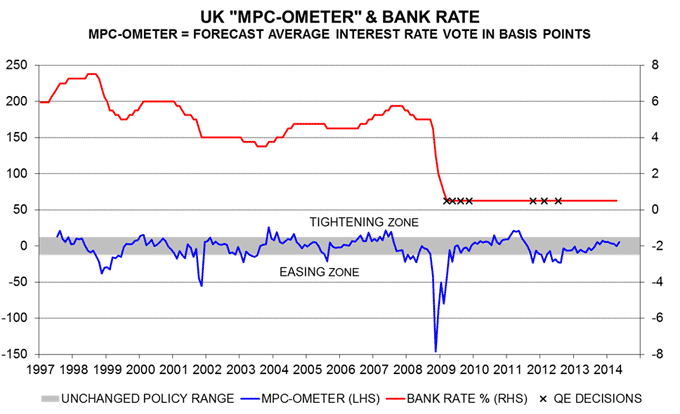UK MPC preview: "MPC-ometer" suggesting hawkish shift
The uneasy truce on the MPC may break down in May, with one or more members expressing support for an early interest rate rise, according to the “MPC-ometer” model followed here.
The MPC-ometer is designed to forecast the “average interest rate vote” of Committee members based on a small number of economic and financial inputs relevant for assessing the outlook for growth and inflation*. Estimated in 2006, the model proved useful for predicting interest rate changes in the late 2000s; it also signalled the expansions of QE in 2011 and 2012**.
The preliminary model reading for May is +5 basis points, formally consistent with two votes for a quarter-point rate hike and seven for no change. The preliminary reading assumes that April PMI and consumer survey results are equal to February / March averages, while the “flash” first-quarter GDP report released on 29 April shows quarterly growth of 1.0%.
With the unemployment rate below 7.0%, MPC members are no longer shackled by the original forward guidance framework. The MPC-ometer reading was negative, signalling an easing bias, when the framework was introduced in August. It turned significantly positive in late 2013 but fell back through April, partly reflecting lower inflation expectations. The May reading, if confirmed, would be the highest since January.
Forward guidance may actually have harmed transparency by limiting MPC members’ ability to communicate how their views have shifted in response to much stronger-than-expected GDP and labour market performance. The May meeting is the hawks’ chance to escape the dove cote. Governor Carney faces a challenge in controlling dissent and convincing markets that forward guidance mark 2 will prove any more durable than its ill-judged predecessor.
*The inputs include GDP growth, business and consumer survey responses about future activity and prices, average earnings growth, changes in share prices and the exchange rate, and credit spreads.
**The model was modified in 2009 to incorporate QE, with the relevant parameter implying that £75 billion of gilt-buying is the policy equivalent of a quarter-point rate cut.


Reader Comments